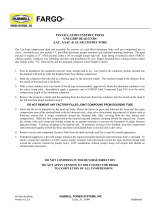Page is loading ...

FARGO
INSTALLATION INSTRUCTIONS
CONVENTIONAL COMPRESSION SPLICES
FOR ACSR CONDUCTORS
The conventional compression splice assembly consists of a steel sleeve and an aluminum splice
body. Both parts are marked with die size, manufacturing date code and FARGO and catalog number.
Aluminum body marks also include conductor type and size.
1. Prior to installation the conductor must be clean, straight and in lay. Any bend in conductor
section to be spliced will tend to make the splice body bow during compression.
2. Conductor tensioning grips must be of a size and type approved by the conductor
manufacturer.
3. Remove the protective plastic and end caps. Be sure the bores of the fittings are clear of
foreign matter. Do not remove any of the grit coating inside the steel barrel. Insert the
conductor into the tapered end of the aluminum splice body and slide the splice body over the
conductor, allowing working room to install the steel splice sleeve on conductor core.
4. Cut-mark the aluminum strands at a distance, from conductor ends, equal to the depth of the
bore in the steel sleeve plus ~3/4” to allow for elongation of the steel sleeve barrel during
compression. Tape wrap the aluminum strands on the span side of the cut mark. Expose the
steel core by removing the aluminum strands to the cut mark. Do not nick the steel strands
while cutting away the aluminum strands.
5. Mount the SH die set, specified on steel sleeve barrel, in press. Lubricate die faces and steel
sleeve half to be compressed first with die lubricant stick or clean oil. Insert conductor core into
the steel sleeve until it bottoms in the sleeve bore. With sleeve seated in one die half, make
the first compression at the knurl mark on sleeve side with conductor core inserted. Continue
compressions out to sleeve end. Overlap crimps slightly - to prevent the formation of ridges
between adjacent crimps. Assure complete die closure with each crimp. Keep the steel sleeve
straight during compression by keeping steel barrel lubricated and fully seat in one die half as
dies close. A BOWED STEEL SLEEVE WILL BOW THE CONDUCTOR JOINT AND MAY
PREVENT THE ALUMIMUNM BODY FROM SLIDING INTO PLACE. - Repeat the process to
compress opposite side conductor core into the steel sleeve.
6. Mark conductor compression length, on both sides of the steel sleeve center, at a distance
equal to half the length of the aluminum splice. Add a second set of marks, for centering the
aluminum body, 4” beyond the compression zone marks.
7. With a clean stainless steel wire brush (V-brush type recommended), aggressively brush the
conductor crimp zone on the joint side where the aluminum splice body is parked, up to the
tape wrap holding strand ends in lay. Immediately apply a generous coat of FARGO Joint
Compound (Type UJC or HTJC) over the just brushed conductor strands. Slide the aluminum
splice body over the compound-coated area to near the tape-wrapped conductor end. Remove
tape wrap. Wire brush the exposed end strands and immediately coat with HTJC.
CONTINUED ON REVERSE
INS 887 (05/26/09) HUBBELL POWER SYSTEMS, INC. Page 1 of 2
Printed in U.S.A. Leeds, AL 35094 1908870000

8. Aggressively brush the strand ends, just beyond tape wrap, of the conductor on the second
joint side and coat that small area with HTJC. Slide the aluminum body until it captures the first
¼” of the compound-coated conductor end. Remove tape wrap and aggressively brush the
remaining crimp zone on second conductor side. Immediately apply a generous coat of UJC or
HTJC over the just brushed conductor strands.
9. Slide the aluminum splice body over the steel sleeve until it is centered between the marks
applied in step 6. Remove and set aside the splice body filler port plug.
10. With a caulking gun, inject FARGO Joint Compound (UJC or HTJC), through the filler port,
until compound begins to flow out between the aluminum body and conductor at one end of the
splice. (See table below for approximate amount of compound required per splice). Hammer
the aluminum plug / pin into the filler hole. Cut, or file, off any excess length of pin and peen
end flush with aluminum barrel.
11. Mount the AH die set specified on the aluminum splice body in press and lubricate die faces
and crimp zone with die lubricant stick, clean oil or clean plastic bag material. (If plastic used
as lubricant, ensure that it wraps completely around the splice tube, fully covering both die face
during each compression). Firmly seat the splice body in one die half and make the first
compression at the knurl mark on first splice side. Make a second overlapping compression on
first splice side. Move press to knurl mark on opposite splice side and make two overlapping
crimps there.
12. At this point in the process (Steel sleeve fully crimped on core and two overlapping crimps on
each side of Aluminum splice body), MINIMUM tension may be applied to remove conductor
slack and help keep splice body straight during the remaining compressions.
NOTE: DO NOT CRIMP SPLICE IN THE REVERSE DIRECTION
13. Re-lubricate die faces and span-end crimp zones. Continue with overlapping compressions to
the ends of the splice. Keep the compression zones well lubricated and keep aluminum body
seated in one die half as dies close.
14. As compressions are completed, wipe off excess joint compound as it is expelled from the
deadend body. Remove any die flash and file or sand for a smooth appearance.
75 76 20 24 27 30 34 36 38 40 42 44 48
FT Splice body 10 0.06 0.10 0.20 0.32 0.44 0.60 0.94 0.98 1.10 1.10 1.40 1.52 1.62
FARGO type UJC-16 Joint Compound required (cartridges per fitting)
Fitting Type
Catalog
Series
Aluminum (AH) Die Size
/





